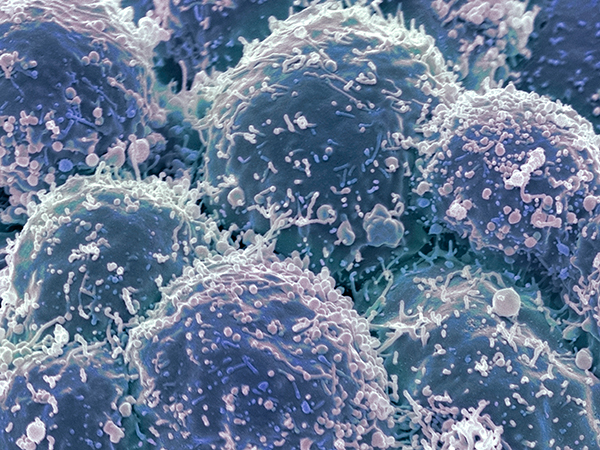Researchers say they have identified networks inside lung cancer cells that will help understand this cancer and treat it with appropriate drugs. Their study (“Integration of Protein Phosphorylation, Acetylation, and Methylation Data Sets to Outline Lung Cancer Signaling Networks”), published in Science Signaling, sheds light on how HSP90 inhibitors, which are currently in clinical trials, work to fight cancer. It is the first large-scale study to analyze three different kinds of protein modifications simultaneously while also employing new methods that involve mathematical and computational approaches and networks to analyze these data, according to the scientists.
“Protein posttranslational modifications (PTMs) have typically been studied independently, yet many proteins are modified by more than one PTM type, and cell signaling pathways somehow integrate this information. We coupled immunoprecipitation using PTM-specific antibodies with tandem mass tag (TMT) mass spectrometry to simultaneously examine phosphorylation, methylation, and acetylation in 45 lung cancer cell lines compared to normal lung tissue and to cell lines treated with anticancer drugs. This simultaneous, large-scale, integrative analysis of these PTMs using a cluster-filtered network (CFN) approach revealed that cell signaling pathways were outlined by clustering patterns in PTMs. We used the t-distributed stochastic neighbor embedding (t-SNE) method to identify PTM clusters and then integrated each with known protein-protein interactions (PPIs) to elucidate functional cell signaling pathways,” write the investigators.
“The CFN identified known and previously unknown cell signaling pathways in lung cancer cells that were not present in normal lung epithelial tissue. In various proteins modified by more than one type of PTM, the incidence of those PTMs exhibited inverse relationships, suggesting that molecular exclusive 'OR' gates determine a large number of signal transduction events. We also showed that the acetyltransferase EP300 appears to be a hub in the network of pathways involving different PTMs. In addition, the data shed light on the mechanism of action of geldanamycin, an HSP90 inhibitor. Together, the findings reveal that cell signaling pathways mediated by acetylation, methylation, and phosphorylation regulate the cytoskeleton, membrane traffic, and RNA binding protein–mediated control of gene expression.”
“Proteins modify each other in different ways inside cells to convey signals,” said Mark Grimes, Ph.D., a cell biologist at the University of Montana (UM). “The signals tell cells to divide, differentiate. or die. Cancer is many diseases, and many types of cancer are caused by screwed-up cell signaling mechanisms. This study defines these signaling pathways with greater precision and integrates pathways that use different protein modifications.”
The study looked at 45 different lung cancer cell types and compared their modified proteins to normal lung tissue. To make sense of the large amount of data, sophisticated pattern-recognition techniques, including machine-learning algorithms, were used, and patterns in protein modifications were combined with protein interaction networks to define cell signaling pathways in lung cancer cells.
Dr. Grimes' team includes other UM scientists and students and researchers from the Icahn School of Medicine at Mount Sinai in New York and Cell Signaling Technology in Massachusetts.
Due to the complexity of the information, Dr. Grimes offers an analogy to get across the main points of the paper:
“Cells are bags of proteins and other components like DNA. Different components are contained within intracellular compartments walled off by membranes. Imagine the cell as a house, and people within are proteins. Different groups of people spend more time in different places, depending on their jobs in the house. In the cell, proteins modify one another by attaching phosphate, methyl, and acetyl groups, which is akin to people attaching different balloons to one another. The balloons attract particular people to come together, depending on which balloon is carried. This sends a signal to the people attracted to the balloon holder to move within the house and engage in some activity. For example, someone hands you a red balloon and you assemble a group of cooks to go to the kitchen and make a meal.
“We can represent the way people interact with one another in the house as a network. Most of the people in the house interact with many other people over the course of a year, so the network of interactions looks like a hairball, which is not very informative. We want to unravel the hairball, picking out pathways through the network that depend on who gets the balloons. This is where mathematical tricks and machine-learning algorithms come into play. These pattern-recognition techniques help us to identify clusters of people who get different balloons—clusters of proteins that become modified—in similar ways. We then look at interactions only among those clusters of people. In other words, the clusters are used to filter the interactions. This cluster-filtered network is a much simpler network, and informs us about signaling pathways specific to lung cancer cells.”
Taking the analogy further, Dr. Grimes says the cluster-filtered network can find the “bad guys” and their collaborators so “we have a better idea who should be arrested by law enforcement to stop the house from expanding in the wrong neighborhood. In other words, this study gives us a better idea which proteins to target with drugs to arrest different types of lung cancer.”


